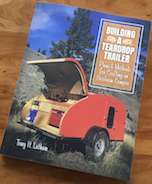twisted lines wrote:Brankulo wrote: torsion axles
seem to absorb more of the bump and resist the bounce afterwards, as compared to same rated leaf spring axles.
Our Work Engineer my minion and myself delivered a new boat, trailer and two large outboards in the truck,
stopped for dinner. Minion Driving out of parking lot
hit a curb; Trailer and boat bounced hard and high 
Very happy with my 2000 Lb Leaf Springs @ 1250 empty! and 2000 lbs Loaded. Its soft maxed.
Long way's till testing #2 with 1 thousand pounder's

This thread reminded me of another, back in 2016
https://www.tnttt.com/viewtopic.php?f=39&t=66773 titled "Offroad Trailer Suspension", where everyone (as usual) gave their considered opinion concerning the merits of each axle (or axle-less) suspension type. Also, as usual, everyone has their position and sticks with it. I'm no different. I believe in leaf spring trailer suspensions, and have my reasons to stick with it.
twisted lines related a story that pinpoints a fundamental reason for my choice: resilience (synonyms include "suppleness" and "strength").
Brankulo stated that
rubber-cored torsion axles absorb force and resist rebound better than
steel leaf springs, whereas
twisted lines countered with an example of steel leaves bouncing hard and high (which, in itself) seems to affirm
Brankulo's assertion. I agree with
Brankulo, but I (like
twisted lines) I am very happy with my (insert weight rating here)lb leaf springs.
I favor leaf springs because of their strength, durability, and their ease of replaceability (which also entails replacing damaged springs quickly, or getting a new set with higher or lower weight ratings, later on). I outlined my prior experience on replacing a broken spring within hours (broken due to age and drastic overloading/overflexing, without using shock absorbers or bumpstops), something not possible on a torsion spring (must be replaced outright), and possible but more delayed repairs on Timbren-type (rubber hollow airspring) or trailing arm-type (with airbag) suspensions, in the other thread listed above.
Lightweight trailers probably will benefit from torsion axles, but unless rubber compounds have gotten better over the years, owners might see a degradation of their axle over a period of years. Years before I built or used any trailers, I learned from the experience of two others that had 10+ year-old pop-up trailers with sagged torsion axles underneath; back then, they scrapped their trailers since no ready-fix was available for either (in the early-mid 60's, in N.Texas, pre-internet, no average Joe knew where to source replacements). 50-60 years later, it may be easier, but not as easy or as cheap, to replace worn or damaged torsion axles as it is to replace leaf springs and associated hardware.
Heavier-weight trailers (we're talking about smaller trailers: teardrops, squarebacks, other TnTTT types, and consumer-not-commercially used utility trailers, only, nor military trailers with torsion-type suspensions...apples not oranges) might require higher rated torsion or leaf springs, which both should ideally get some assistance resisting excess travel & rebound cycles, which will wear either type down over years of usage. I know of no external aid for torsion axles, but leaf spring axles can benefit from using shock absorbers and/or bumpstops that limit or absorb excess travel & flex, which stress the suspension components more, the heavier the trailer gets. My 4x8 squareback has always been a comparative heavyweight, and needed assistance in the form of "progressive bumpstops" that I made for it.
adapted text, from the thread I listed above:working on it wrote:Both times that I've experienced broken leaf springs (and the one-unmentioned shackle tear-off) there was no bumpstop to cushion/limit the flexing of the spring past its' working arc limits... The leaf spring had nothing limiting it from flattening out, or even reversing its' normal arced shape... (thus) bottoming out, resulting in a severe jolt, and breakage...
Now (after 2014), even Timbren recognizes the problems of over-travel in their suspension, and sees the need to "progressively" absorb the energy before the absolute "stop". I chose not to use shock absorbers with my new leaf spring suspension (with relatively little travel), reasoning that the shock absorbers couldn't absorb enough energy in their limited motion to do much good before their absolute stop was reached.And, I was going to add a bumpstop to prevent the possible overtravel of the leaves past the flattened arc stage. So, I combined the functions of shock absorber and bumpstop into one, using a Daystar progressive bumpstop, made of resilient polyurethane, as an active part of the system (always in contact with, and following the motion of the axle); sorta like Timbren does with their component. I described my "active bumpstop suspension" in my thread:
http://www.tnttt.com/viewtopic.php?f=35&t=59570#p1075076.
I modified the Daystar bumpstop to be softer-acting (by cutting away the hard "bump" of the top of the piece, and curved the remaining body to slip-fit between my axle and frame (at full droop of the springs). With the top part of bumpstop so modified, the remainder relies on the two lower "ligaments" to progressively flatten out, before compression into the bottom layer, when the overtravel is finally prevented.
I wondered how well it would work, as did may doubters on the forum, but I think it proved itself when I encountered a large chughole in the road at 75 mph. My truck and trailer both got bounced into the air, with my truck tires being the only damaged parts afterwards. In normal driving situations, I really haven't noticed any of the trailer bounce that I should be seeing, as a result of using too stiff of springs. In any case, the bumpstop at least kept the leaves from overflexing, preventing breakage. If I ever soften the suspension, and/or add conventional shock absorbers (if suspension travel becomes greatly increased), I will still use some form of progressive bumpstop to limit overtravel. I try different things, sometimes re-purposed from originally designed function, to do what I need them to. Sometimes it works....







